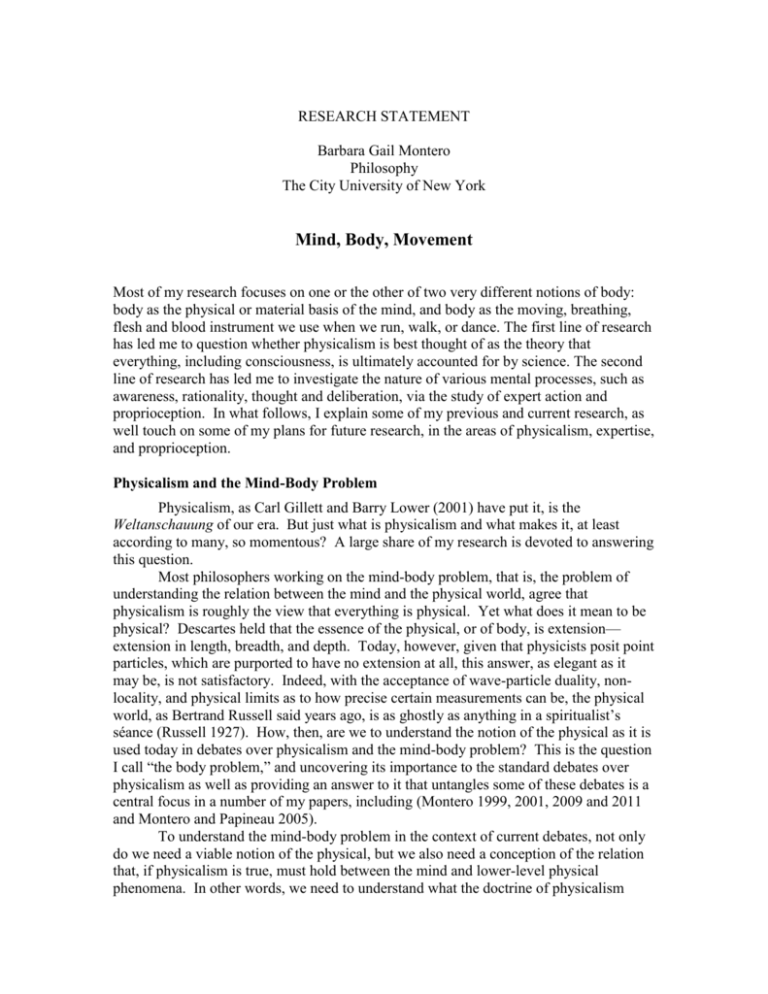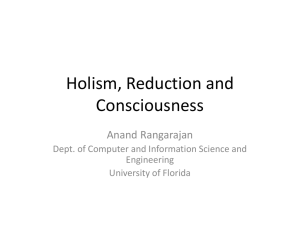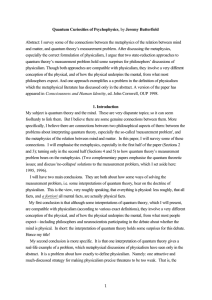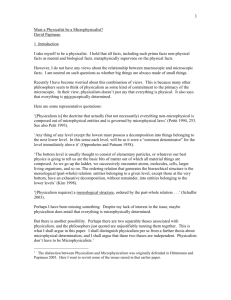Reasearch Statement - Barbara Gail Montero
advertisement

RESEARCH STATEMENT Barbara Gail Montero Philosophy The City University of New York Mind, Body, Movement Most of my research focuses on one or the other of two very different notions of body: body as the physical or material basis of the mind, and body as the moving, breathing, flesh and blood instrument we use when we run, walk, or dance. The first line of research has led me to question whether physicalism is best thought of as the theory that everything, including consciousness, is ultimately accounted for by science. The second line of research has led me to investigate the nature of various mental processes, such as awareness, rationality, thought and deliberation, via the study of expert action and proprioception. In what follows, I explain some of my previous and current research, as well touch on some of my plans for future research, in the areas of physicalism, expertise, and proprioception. Physicalism and the Mind-Body Problem Physicalism, as Carl Gillett and Barry Lower (2001) have put it, is the Weltanschauung of our era. But just what is physicalism and what makes it, at least according to many, so momentous? A large share of my research is devoted to answering this question. Most philosophers working on the mind-body problem, that is, the problem of understanding the relation between the mind and the physical world, agree that physicalism is roughly the view that everything is physical. Yet what does it mean to be physical? Descartes held that the essence of the physical, or of body, is extension— extension in length, breadth, and depth. Today, however, given that physicists posit point particles, which are purported to have no extension at all, this answer, as elegant as it may be, is not satisfactory. Indeed, with the acceptance of wave-particle duality, nonlocality, and physical limits as to how precise certain measurements can be, the physical world, as Bertrand Russell said years ago, is as ghostly as anything in a spiritualist’s séance (Russell 1927). How, then, are we to understand the notion of the physical as it is used today in debates over physicalism and the mind-body problem? This is the question I call “the body problem,” and uncovering its importance to the standard debates over physicalism as well as providing an answer to it that untangles some of these debates is a central focus in a number of my papers, including (Montero 1999, 2001, 2009 and 2011 and Montero and Papineau 2005). To understand the mind-body problem in the context of current debates, not only do we need a viable notion of the physical, but we also need a conception of the relation that, if physicalism is true, must hold between the mind and lower-level physical phenomena. In other words, we need to understand what the doctrine of physicalism entails about the relation between mind and body. Contemporary philosophers working on these issues have invariably held that one such relation is supervenience, where supervenience is supposed to capture the idea, roughly speaking, that a set of properties determines, or suffices for, another set of properties. The supervenience of mental properties on fundamental physical properties is taken as a necessary condition for physicalism because the failure of such supervenience is thought to render mental properties nonphysical; and if there is something nonphysical, then physicalism is false. Accordingly, the standard arguments against physicalism, such as the knowledge argument and the zombie argument, all purport to establish that certain mental properties do not supervene on the fundamental properties of physics. In a forthcoming paper, I argue that the world could be entirely physical even if the mental fails to supervene on the physical, or in other words, that physicalism does not entail the supervenience of the mental on the physical (forthcoming a) and in a paper in progress, “Irreverent Physicalism,” I propose a way of thinking about physicalism without supervenience. Other work I have done on the mind-body problem covers a variety of topics. For example, in (2007) I present my view that, if we accept a Kantian understanding of the a priori, Frank Jackson’s “Mary in the black and white room” argument is not valid; in (2006a), I argue that, contrary to popular belief, the conservation of energy law is consistent with interactive dualism and thus irrelevant to the truth of physicalism; in (2006b), I propose a formulation of physicalism that is viable even if there is no fundamental level of reality; and in (2010 and forthcoming b), I discuss the philosophical position on the mind-body problem, referred to as “Russellian monism,” characterized roughly as the view that consciousness is determined by the intrinsic properties of fundamental physical entities, and argue that it is actually a form of physicalism. I also have a number of projects related to the mind-body problem in the works. These include a paper on nineteenth-century German philosophy of mind, covering, among other topics, the Materialismusstreit, which was a controversy over the plausibility of a purely materialistic as opposed to religious understanding of life (forthcoming c), a paper on panpsychism (forthcoming d), which is the view that everything has an aspect of mentality, and, in collaboration with David Papinaeu, an article on the overlap, and lack thereof, between naturalism and physicalism (forthcoming e). Finally, I have had preliminary discussions with Oxford University Press about writing a book on physicalism that would consolidate my ideas on the body problem and supervenience; I plan to write this after completing my book, described below, on expertise. The Mind of the Expert in Action I am currently in the midst of writing a book, Mind, Body, Movement: The Role of Effort in Expert Action, that explores the role of effort as well as thought, attention, conceptualization, bodily awareness, and intuition in expert-level actions (forthcoming f). Clearly, highly skilled musicians, dancers and athletes need to work hard to attain their prowess. However, it is commonly held, in both academia and popular culture, that once expertise is developed, one’s actions are, in some sense, effortless. In fact, skill, according to the classic definition, “consists in the ability to bring about some end results with maximum certainty and minimum outlay of energy, or of time and energy” (Guthrie 1952). My main goal in the book is to critically examine this view and advance what I call “the principle of expert mindedness,” which states that effort, thought, bodily awareness and other such psychological factors are often integral to the smooth, apparently effortless execution of expert level skills. Contrary to the idea that expert action proceeds automatically, I argue that experts in fact present a model of Socratic rationality, exemplifying both conceptually grounded knowledge of actions and selfawareness. The book aims, in part, to counter the widely accepted view that focusing on what you are doing, especially focusing on your own bodily movements, interferes with highly skilled performance—“paralysis by analysis,” is what the psychologist Sian Beilock calls it (2010 passim)—and it involves an attempt both to clarify concepts, ideas and empirical findings related to expertise, and to engage with the ideas of philosophers, such as Herbert Dreyfus and Sean Kelly, whose thoughts on expert action are grounded in the phenomenological tradition of Maurice Merleau-Ponty and Martin Heidegger. The interdisciplinary nature of the project makes it challenging to write, however, my hope is that the book will appeal to a broad range of researchers, including philosophers in both the analytic and continental tradition, as well as researchers in psychology, neuroscience, dance and music theory, psychology, sports medicine and physiology. A number of ideas in this book have developed out of my prior research on the relation between the conscious mind and skilled performance which has resulted in papers on the relevance of bodily awareness to expert skill (2010), on the mind of the expert in high-level chess (2011b, and forthcoming g), and on the mind of the expert in professional ballet (forthcoming h). The book also draws from my forthcoming papers on effortlessness (forthcoming i and forthcoming j). In these papers, I explore what it means for an action to be effortless, how we perceive effortlessness and what we value about effortless actions. The principle of expert mindedness implies that expert actions require effort, but not that every aspect of them requires effort. Thus, in these papers as well as in the book, I address the question of wherein the expert’s effortlessness resides. Proprioception, Aesthetics, and Neuroscience Close your eyes and lift your arms overhead so that your palms touch. What enables you to do this is proprioception, the sense by which we acquire information about the positions and movements of our own bodies, via receptors in the joints, tendons, ligaments, muscles, and skin. Charles Sherrington (1906), who coined the term, referred to it as our “secret sixth sense,” and although our understanding has deepened over the intervening years, the idea of a proprioceptive sense retains a bit of its secrecy, as it is a relatively unexplored area of research. This is unfortunate, for if, as Blaise Pascal (1670/1966) claims, “our nature lies in movement,” the study of proprioception is vitally important. Another component of my research aims at furthering our philosophical understanding of proprioception (Montero 2006c, 2006d and Cole and Montero 2007). One view I have argued for is that vision allows us not only to see another person’s movements but also to kinesthetically experience them. In watching someone else move, it is very much as if the perceiver, though stationary, were moving herself. I call this, “propriocieving another’s movement,” and some of my recent work on dance employs this notion. In (Montero 2012 and forthcoming k), I argue that dance training is relevant to one’s aesthetic evaluation of dance, in particular, that there are certain aspects of dance—aspects that have to do with the way in which watching dance movements produce an “internal resonance” of these movements in an observer’s body—that tend to be missed, or at least, not fully appreciated, by those who cannot, or at least have never danced themselves. (This is not to say that those with dance training are necessarily better aesthetics judges of dance than those without; whether dance training interferes with one’s ability to judge other aesthetic qualities, I leave as an open question.) Part of this project involves mining some recent empirical literature that uses dance as a research tool for understanding links between action perception and action execution. I argue that this literature indicates that dance practice may heighten an observer’s ability to proprioceive a dancer’s movement, or in other words, it improves one’s “motor-perception” of dance. The neuroscientific literature, on the one hand, indicates that certain areas of the brain subserving bodily movement show a relatively high degree of activity when individuals watch movements that they have been trained to perform (Calvo-Merino 2005 and 2010 and Cross 2006). The behavioral studies, on the other hand, suggest that dance training facilitates the ability to detect certain subtle differences between dance movements (Casile 2006 and Calvo-Merino 2006). I argue that together these strands of research provide good reason to think that dance training improves one’s motor-perception of dance. Moreover, if motor-perception is aesthetically relevant, as I argue it is, we are lead to the idea that dance training can improve the aesthetic appreciation of certain aspects of dance. This research is also relevant to the debate over enactivism, which is roughly the view that conscious visual experience is grounded in our ability to move about in the world. In a paper in progress, I argue that at least with respect to our perception of dance, a weak form of enactivism is correct. There are a number of other issues related to proprioception that I am eager to explore. In the empirical literature on proprioception, there is disagreement about what type of awareness proprioception provides. For example, some take the term “proprioception” to apply only to our detection of specific movements and positions—for example, that my leg is moving forward—while others take it to also apply to our detection of movement in general—for example, that my leg is moving (Weiler and Awiszus 2000); some assume proprioception can be improved while others think that it cannot (Ashton-Miller 2001); some understand proprioception as a form of nonconscious information processing; some understand it as a type of awareness, either perceptual or non-perceptual. In future work, I would like to delve into these issues. The Years Ahead I imagine I shall continue to write about physicalism, expertise, and proprioception for many years. However, I also imagine that new topics will capture my attention, and although I cannot predict what they may be, it is a good bet that my work on them will aim to further our understanding of the mind. REFERENCES Ashton-Miller, J. A., E. Wojtys, L. Huston, D. Fry-Welch (2001), “Can Proprioception Really Be Improved by Exercises?” Knee Surgery, Sports Traumatology, Arthroscopy, 9: 128-136. Calvo-Merino, B., Glaser, D. E., Grezes, J., Passingham, R. E., Haggard, P. (2005), “Action observation and acquired motor skills: an fMRI study with expert dancers” Cerebral Cortex 15(8), 1243-1249. Calvo-Merino, B., Grèzes, J., Glaser, D. E., Passingham, R. E., Haggard, P. (2006), “Seeing or doing? Influence of visual and motor familiarity in action observation,” Current Biology 16(19), 1905-1910. Calvo-Merino, B., Ehrenberg, S., Leung, D., Haggard, P. (2010), “Experts see it all: configural effects in action observation,” Psychological Research, 74(4), 400-406. Casile A, Giese M. A. (2006), Non-visual motor learning influences the recognition of biological motion, Current Biology, 16(1):69-74. Cole, J. and B. Montero (2007), “Affective Proprioception,” in a special edition of Janus Head edited by S. Gallagher. Gillett, C. and B. Lower (2001), Physicalism and Its Discontents, Cambridge University Press. Guthrie, E. R. (1952), The Psychology of Learning, (New York: Harper and Row). Montero, B. (1999), The Body Problem, Noûs, 33: 3 (1999) pp. 183-20. Montero, B. (2001), “Post-Physicalism,” Journal of Consciousness Studies, 8: 2 (2001) pp. 61-80. Montero, B. (2005), “The Via Negativa Argument for Physicalism,” co-written with David Papineau, Analysis, Vol. 65, No. 3 (2005) pp. 233-237. Montero, B. (2006a), “What Does the Conservation of Energy Have to Do with Physicalism?” Dialectica 60:4 (2006), pp. 383–396. Montero, B. (2006b), “Physicalism in an Infinitely Decomposable World” Erkentnis, 64: 2, pp. 177-191. Montero, B. (2006c), “Proprioception as an Aesthetic Sense,” Aesthetics and Art Criticism, 64: 2, pp. 231-242 Montero, B. (2006d), “Proprioceiving Someone Else’s Movement,” Philosophical Explorations, pp. 149-161. Montero, B. (2007), “Physicalism Could Be True Even If Mary Learns Something New,” Philosophical Quarterly 57, pp. 176-189. Montero, B. (2009), “What is the Physical?” in Oxford Handbook in the Philosophy of Mind, McLaughlin B. and A. Beckermann. eds. (Oxford University Press), pp. 173188. Montero, B. (2010a), “A Russellian Response to the Structural Argument Against Physicalism,” Journal of Consciousness Studies 17: 3-4, 70-83. Montero, B. (2010b) “Does Bodily Awareness Interfere with Highly Skilled Movement?” Inquiry, 53, 105- 122. Montero, B. and Evans, C. (2011), “Intuitions without Concepts Lose the Game: Mindedness in the Art of Chess,” Phenomenology and Cognitive Science, 10:2, 175-194. Montero, B. (2011a), “Physicalism,” in The Continuum Companion to the Philosophy of Mind, Garvey, J, ed. Continuum Press. Montero, B. (2011b), “Intuitions Without Concepts Lose the Game: Mindedness in the Art of Chess” (with Cory Evans), Phenomenology and Cognitive Science, 10:2, 175-194. Montero, B. (2012), “Practice Makes Perfect: The Effect of Dance Training on the Aesthetic Judge,” Phenomenology and Cognitive Science, 11:1, 59-68. Montero, B. G. (forthcoming a), “Must Physicalism Imply the Supervenience of the Mental on the Physical?” Journal of Philosophy Montero, B. G. (forthcoming b), “Russellian Physicalism” in The Intrinsic Nature of Matter: Essays on Russellian Monism, edited by Alter, T. and Y. Nagasawa, Oxford University Press. Montero, B. G. (forthcoming c), “Philosophy of Mind,” The Oxford Handbook of 19th Century German Philosophy, edited by Forster, M. and G. Kristen (Oxford University Press). Montero, B. G. (forthcoming d), “Panpsychism and the Hard Problem,” Panpsychism, edited by Brüntrup, G., Oxford University Press. Montero, B. G. and D. Papineau (forthcoming e), “Naturalism and Physicalism,” Blackwell Companion to Naturalism, edited by Clark, K., (Blackwell). Montero, B. G. (forthcoming f), Mind, Body, Movement: The Role of Effort in Expert Action, (Oxford University Press). Montero, B. G. and Evans, C. (forthcoming g), “Thoughts without Words: Response to Gobet,” Phenomenology and Cognitive Science. Montero, B. G. (forthcoming h), “A Dancer Reflects: Deliberation in Action” in Mind, Reason and Being-in-the-World The McDowell-Dreyfus Debate, Edited by Joseph Shear, J. ed. Routledge. Montero, B. G. (forthcoming i) “Effortless Bodily Movement,” Philosophical Topics. Montero, B. G. (forthcoming j), “Aesthetic Effortlessness,” Body Aesthetics, edited by Irvin, S. (Oxford University Press). Montero, B. G. (forthcoming k), “The Artist as Critic: Dance Training, Neuroscience and Aesthetic Evaluation,” Journal of Aesthetics and Art Criticism. Pascal, B. (1670/1966), Pensees (London: Penguin). Russell, B. (1927), Analysis of Matter, London: Kegan Paul (1927). Sherrington, C. (1906/1947), The Integrative Action of the Nervous System (Cambridge: Cambridge: Cambridge University Press). Weiler, H.T. and F. Awiszus (2000), “Influence of Hysteresis on Joint Position Sense in the Human Knee Joint,” Experimental Brain Research, 135:2, pp. 215-221.







